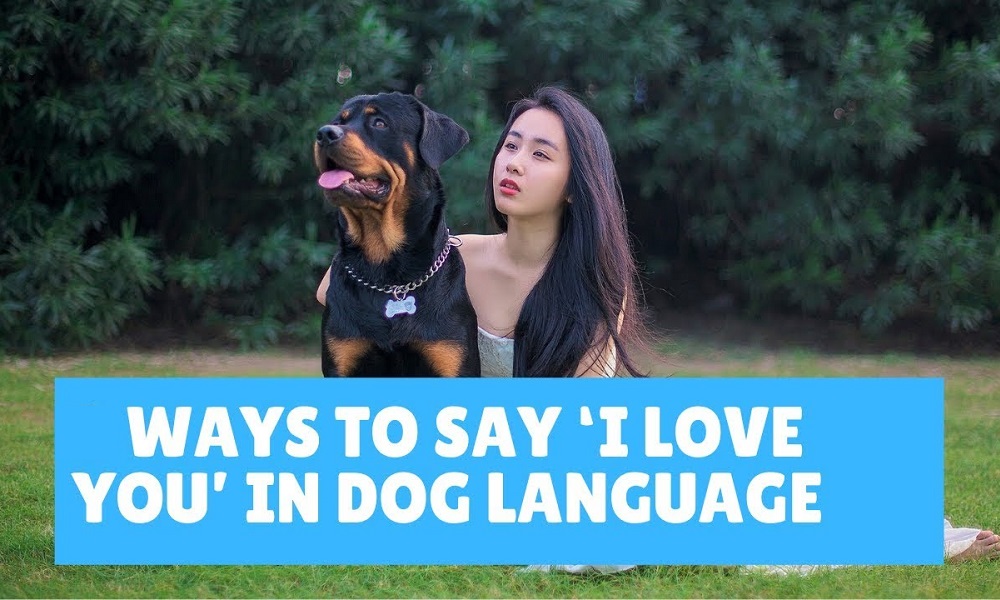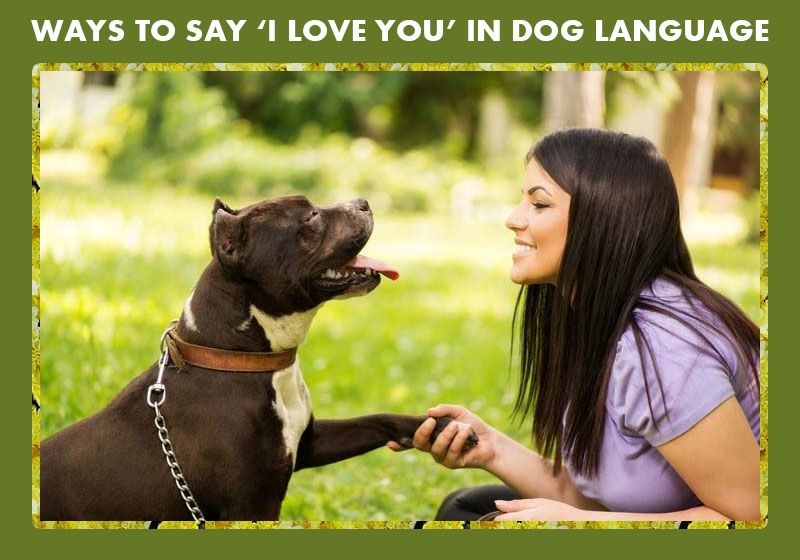Dogs are one of the most popular pets in the world, and their loveable nature is a big part of why. Dogs have a unique way of showing affection to their owners and family members that goes beyond just wagging their tails. If you want to know how to say “I love you” in dog language, here are a few things to look for.
One way that dogs show they love you is by bringing you things. This could be anything from a toy to a stick they found outside. They do this because they want to make you happy and they know that you’ll appreciate the gesture.
Another way dogs show affection is through physical contact. They might lean against you, rest their head on your lap, or give gentle kisses on the hand or face. Of course, every dog is different and will express love in different ways.

But these are just some of the more common ways that dogs say “I love you.” If you’re ever unsure about how your dog is feeling, simply ask them! They’ll be more than happy to tell you what’s on their mind – even if it’s just lots of sloppy kisses. Some important tips?
- Look into your dog’s eyes and give them a soft stare
- Lean in close to your dog, making sure not to invade their personal space
- Gently place your hand on their head or back, depending on what makes your dog comfortable
- Slowly say “I love you” in a soft voice while maintaining eye contact with your dog
What is the Love Language of a Dog?
Dogs are social creatures that thrive on companionship and positive reinforcement. Just like humans, every dog has its own unique personality and therefore, its own love language.
While some dogs may enjoy a good belly rub or a game of fetch, others may prefer a more gentle approach such as being spoken to in a soft voice or receiving slow petting.
In order to figure out what your dog’s love language is, it is important to spend time observing their behavior and taking note of what makes them happiest. One of the most common love languages among dogs is physical touch.
This can manifest itself in different ways depending on the dog, but typically includes things like being petted, rubbed, hugged or kissed. For some dogs, this type of affection is essential in feeling loved and secure, while others may only enjoy it occasionally.
If you’re not sure whether your dog falls into the latter category or not, err on the side of caution and resist the urge to smother them with kisses let them come to you for cuddles instead. Another popular love language among dogs is quality time.
This simply means spending one-on-one time with your furry friend without any distractions such as phones, TVs or other people/pets around. It gives them undivided attention and lets them know that they are an important part of your life.
Quality time can be anything from going for walks together to playing tug-of-war or simply sitting next to each other while you read a book. Whatever you do together just make sure both of you are fully present and enjoying each other’s company.
The last two commonly observed love languages in dogs are food rewards and toys/praise. Food rewards are exactly what they sound like using treats as a way to show your affection (just be careful not to overdo it!). Toys/praise usually go hand-in-hand since most dogs LOVE playing with their favorite toys this could be anything from a squeaky toy to a ball or Frisbee.
When they bring the toy back to you or perform a trick successfully, showering them with verbal praise will reinforce how happy you are with their behaviour which will only make them want to please you even more! So there you have it – four possible love languages that your dog might speak!
How Do You Say I Love You to Your Pet?
We all know that our pets are a big part of our lives and we want to show them how much we care. Sometimes it can be hard to find the right words, but luckily there are some tips that can help. First, it’s important to remember that your pet doesn’t understand human language in the same way that we do.
This means that they won’t necessarily understand what you mean when you say “I love you.” However, they will be able to pick up on your tone of voice and body language. So, if you say “I love you” in a warm and loving voice while giving your pet a big hug, they will definitely get the message!
There are also some specific things you can do to show your pet how much you love them. Treats are always a good option most pets love food! You could also give them extra attention and cuddles, or buy them a new toy to play with. Whatever you do, just make sure that your actions match your words and they’ll definitely feel the love.
How Do I Speak to My Dog?
There are a few things to keep in mind when you’re trying to speak to your dog.
First, it’s important to use a tone that is cheerful and upbeat – this will let your dog know that you’re happy to be talking to them.
Secondly, make sure that you use clear and concise commands – your dog won’t understand if you start babbling on about something else!
Finally, it’s helpful to use hand gestures along with your words – this can help your dog understand what you want them to do.
Do Dogs Know You Kiss Them?
When it comes to showing affection, dogs are usually more than happy to oblige. Many owners enjoy kissing their pups on the nose or top of the head. But do dogs really know that we’re kissing them, or are they just tolerating our displays of affection?
The answer may depend on the dog. According to a recent study, some dogs show signs that they understand kisses are a gesture of love and appreciation. The research, conducted by scientists at Osaka University in Japan, found that when people kissed their dogs, the pups showed positive changes in their behavior.
The researchers observed 30 dog-owner pairs and noted how each pair interacted during three different scenarios: When the owner was talking to the dog; when the owner was petting the dog; and when the owner kissed the dog.
They found that when owners kissed their dogs, the pups became more relaxed and had an increase in heart rate and cortisol levels (a hormone associated with stress). This suggests that kisses may help reduce stress in dogs.
Interestingly, not all dogs responded positively to being kissed by their owners. Some showed no change in behavior, while others even seemed stressed by the experience. This could be due to individual differences in temperament or previous experiences with being touched or handled roughly.
It’s also possible that some dogs simply don’t enjoy being kissed on the face. If your dog doesn’t seem to like it when you kiss them, it’s probably best to stick to petting or other forms of physical affection instead.

Credit: www.bestvetcare.com
Conclusion
Many people think that saying “I love you” to their dog is enough, but did you know that there are other ways to say it in dog language? Here are some tips on how to show your pup some love:
1. Get down on their level: Dogs feel more comfortable when we’re at their eye level, so get down on the floor and give them a big hug.
2. Give them a good petting: Dogs love being petted, especially behind the ears and on the chest. So take some time to really show your pup some affection.
3. Speak in a soft voice: Dogs can pick up on our tone of voice, so speaking softly will let them know that you’re gentle and kind.
4. Make eye contact: Dogs communicate a lot through body language, so making eye contact is a great way to show them you care.